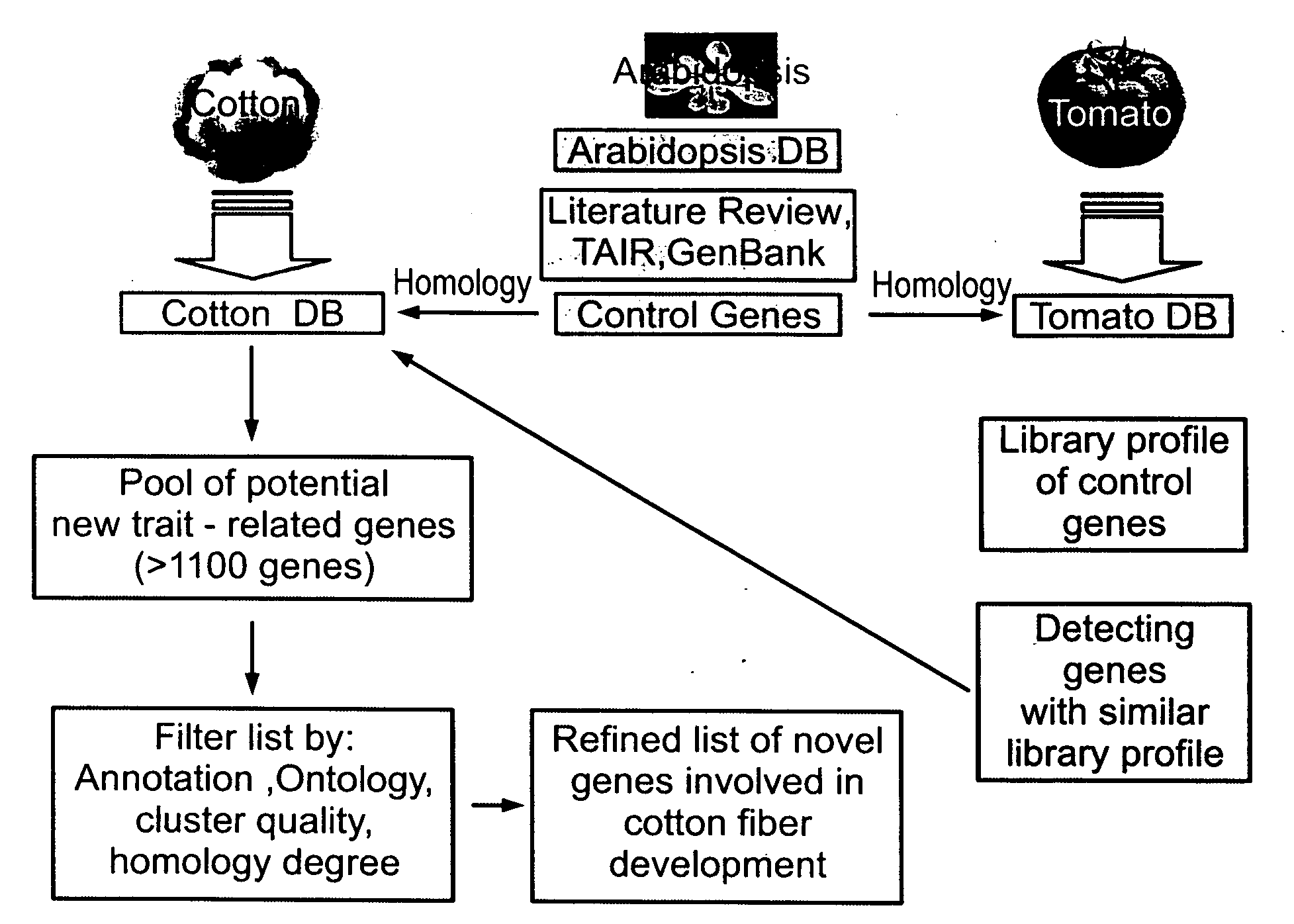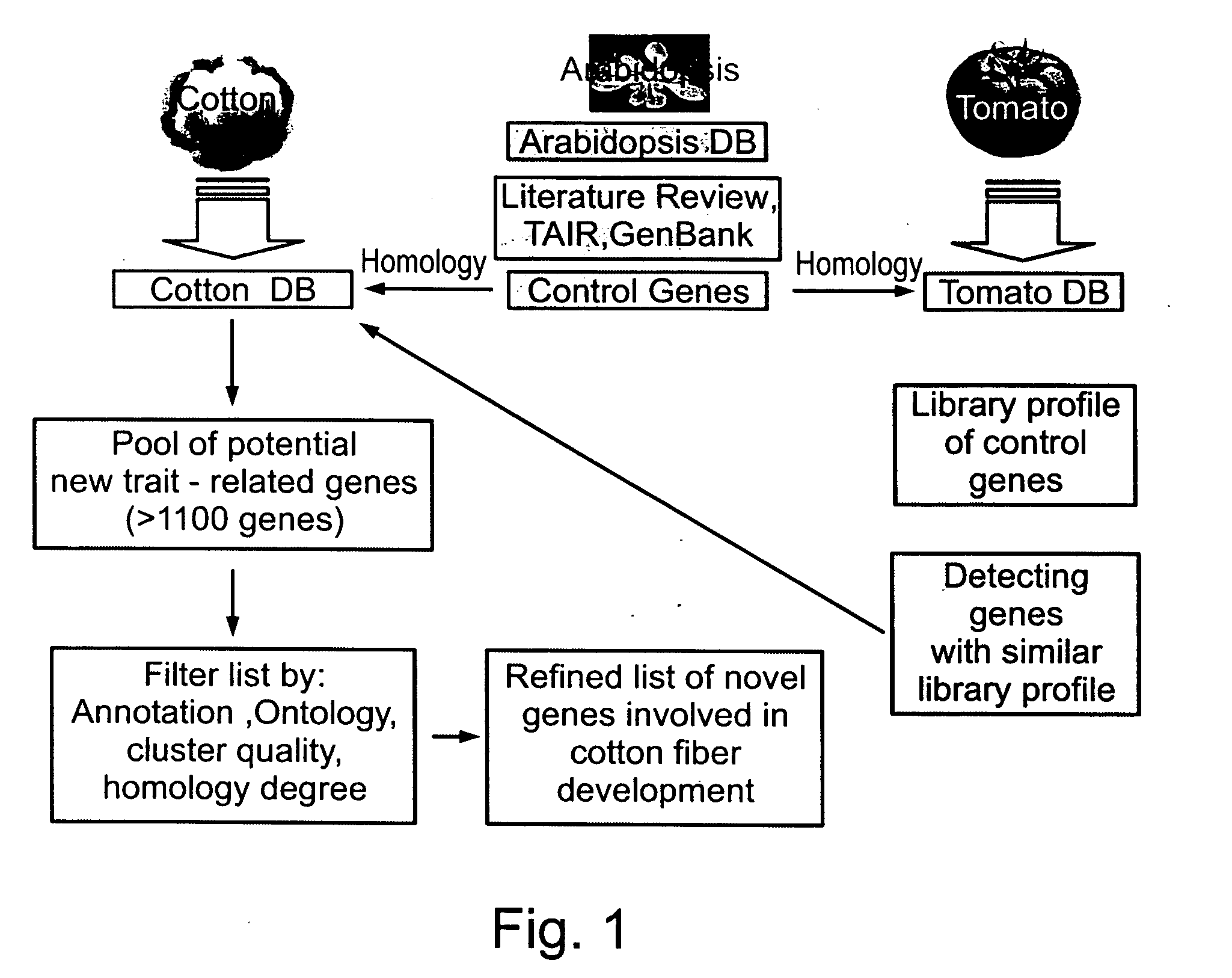Polynucleotides and polypeptides involved in plant fiber development and methods of using same
- Summary
- Abstract
- Description
- Claims
- Application Information
AI Technical Summary
Benefits of technology
Problems solved by technology
Method used
Image
Examples
example 1
In Silico Identification of Cotton Genes Involved in Fiber Formation
[0210]Experimental Procedures
[0211]Interspecies comparison of expressed sequences—Two main tools were used during the data mining stage. Large numbers of gene profiles were queried from an ORACLE database housing Compugen's GeneCarta platform (Compugen Ltd. Israel). This data was loaded into MicroSoft Excel spreadsheets for further manual refinement. Using this data a cross species genomic comparison was effected, aiming at defining organs from other plant species for which publicly available EST libraries can be used both as models and as new sources of information to define new genes with key role in fiber formation (FIG. 1). This comparison analysis used mainly the cotton, arabidopsis and tomato databases.
[0212]Clustering and inter-species clustering of EST sequences—The cotton genomic database included less than 50,000 ESTs (Genbank release #135) originating primarily from two species Gossypium arboreum (˜35,000...
example 2
mRNA Expression Analysis of Genes Identified According to the Teachings of the Present Invention
[0228]To study the RNA expression profile of candidate genes identified as described in Example 1 above, a reverse transcription was effected followed by real time PCR (RT-qPCR).
[0229]Experimental Procedures
[0230]Quantitative Real time PCR analysis (qRT PCR)—To verify the levels of expression specificity and trait-association, Reverse Transcription following quantitative (Real-Time) PCR (RTqPCR) was effected. Total RNA was extracted at different stages of fiber development (from the day of anthesis till day 20—post anthesis). To study the specificity of expression, RNA from other tissues of the cotton plants were collected and analysed for control expression (i.e., young leaves, young stems, mature stems, young roots, sepals, petals, and stamen). For this purpose, RNA was extracted from Cotton tissue using Hot Borate RNA Extraction protocol according to www.eeob.iastate.edu / faculty / Wendel...
example 3
Analysis of Gene Expression Using Publicly Available Microarrays
[0242]Further information about the expression of the selected genes (Example 2, above) was retrieved by statistical analysis of microarray data from arabidopsis. Essentially, the best homologs of the new candidate genes in arabidopsis were compared to a set of 77 microarrays experiment of different tissues of Arabidopsis (AtGenExpress databases, the Principal investigator for AFGN: Prof. Dr. Lutz Nover, Botanisches Institut, Molekulare Zellbiologie, FB Biologie und Informatik der J. W. Goethe Universität Frankfurt; Biozentrum N200 3OG, Marie-Curie-Strasse 9, 60439 Frankfurt am Main, www.arabidopsis.org / info / expression / ATGenExpressjsp).
[0243]Polynucleotide sequences that were highly expressed in elongated cells or inflorescence meristems were selected for further analysis.
[0244]Table 4 below lists tissues which exhibit the highest levels of gene expression.
TABLE 4Tissues with highexpressionspecificityRelated to fiberCT_...
PUM
| Property | Measurement | Unit |
|---|---|---|
| Fraction | aaaaa | aaaaa |
| Length | aaaaa | aaaaa |
| Length | aaaaa | aaaaa |
Abstract
Description
Claims
Application Information
 Login to View More
Login to View More - R&D
- Intellectual Property
- Life Sciences
- Materials
- Tech Scout
- Unparalleled Data Quality
- Higher Quality Content
- 60% Fewer Hallucinations
Browse by: Latest US Patents, China's latest patents, Technical Efficacy Thesaurus, Application Domain, Technology Topic, Popular Technical Reports.
© 2025 PatSnap. All rights reserved.Legal|Privacy policy|Modern Slavery Act Transparency Statement|Sitemap|About US| Contact US: help@patsnap.com



